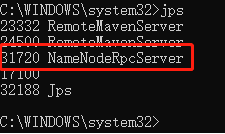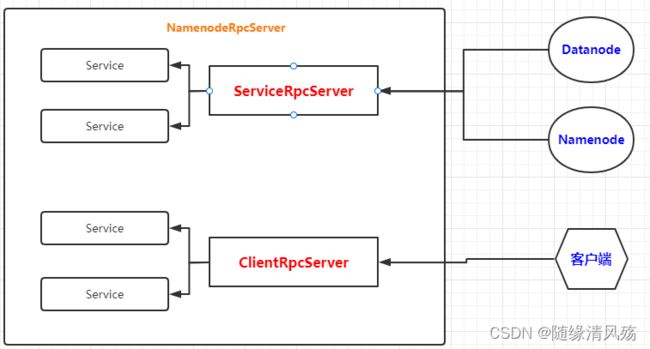第六章 数据中台PaaS层离线存储之HDFS源码剖析第一部分 - NameNode启动流程&HadoopRpc协议详述
1、大数据源码解读思路
(1)掌握其网络通信架构
(2)场景驱动方式
-
HDFS:
-
namenode datanode启动
-
写数据得流程
-
更新原数据流程
-
读数据流程
-
2、Hadoop RPC的Demo详述
- 含义:远程过程调用,即不同进程的方法的调用。
2.1、创建pom依赖
<dependency>
<groupId>org.apache.hadoopgroupId>
<artifactId>hadoop-clientartifactId>
<version>2.7.0version>
dependency>
2.2、相关源码调试
(1)创建客户端和服务端通信协议接口
/**
* 协议
* @author Administrator
*
*/
public interface ClientProtocol {
long versionID=1234L;
void makeDir(String path);
}
(2)服务端相关源码开发
public class NameNodeRpcServer implements ClientProtocol {
/**
* 创建⽬录
*/
@Override
public void makeDir(String path) {
System.out.println("服务端:"+path);
}
// 构建服务端
public static void main(String[] args) throws Exception {
Server server = new RPC.Builder(new Configuration())
.setBindAddress("localhost")
.setPort(9999)
.setProtocol(ClientProtocol.class)
.setInstance(new NameNodeRpcServer())
.build();
//启动服务端
server.start();
}
}
- 运行情况:服务端启动会一直等待客户端调用
- 查看进程:通过JPS查看进程
(3)客户端相关源码开发
/**
* RPC客户端
* @author Administrator
*
*/
public class DFSClient {
public static void main(String[] args) throws IOException {
ClientProtocol namenode = RPC.getProxy(ClientProtocol.class,
ClientProtocol.versionID,
new InetSocketAddress("localhost",9999),
new Configuration());
namenode.makeDir("/user/opt/soft");
}
}
- 查看运行结果:客户端调用服务端方法,方法的执行在服务端。
(4)Hadoop RPC特性
①RPC其实指的不同进程之间的调用,例如客户端调用服务端方法,方法的执行在服务端;
②协议接口特征:接口里面必须有VersionID;
③接口协议:服务端会实现接口(协议里面的方法);
④hadoop rpc的服务端,我们在JPS时候是可以看得到的。
⑤服务端和客户端创建
- 服务端:接受参数,创建方法。
- 客户端:传递参数,调用服务端方法。
3、源码剖析之namenode启动流程
3.1、第一步 - Name注释概述
(1)NameNode服务管理了两个重要的表
-
namespace:管理了文件与block之间的关系,存储到磁盘上。
- 关系固定,不会发生变化。
-
inodes:管理了Block与主机之间的关系,每次重启重新构建。
- 关系不固定,档一个节点挂掉,文件块就会挪到另外一台服务器上。
(2)NameNode服务由三个重要类支撑
①NameNode类:管理配置的参数
②NameNode Server
- IPC Server:开发端口等待别人调用
- HTTP Server:开放50070界面,可以通过该界面了解HDFS的情况
③FSNameNameSystem:管理了HDFS的元数据
3.2、NameNode的main方法源码剖析
public static void main(String argv[]) throws Exception {
// 1、解析參數如果异常则退出
if (DFSUtil.parseHelpArgument(argv, NameNode.USAGE, System.out, true)) {
System.exit(0);
}
try {
StringUtils.startupShutdownMessage(NameNode.class, argv, LOG);
///2、创建NameNode
NameNode namenode = createNameNode(argv, null);
// 3、如果NameNode不为空则线程阻塞
if (namenode != null) {
namenode.join();
}
} catch (Throwable e) {
LOG.error("Failed to start namenode.", e);
terminate(1, e);
}
}
3.3、createNameNode源码剖析
- 集群启动参数传递:hadoop-daemon.sh start namenode
public static NameNode createNameNode(String argv[], Configuration conf) throws IOException {
LOG.info("createNameNode " + Arrays.asList(argv));
if (conf == null)
conf = new HdfsConfiguration();
// 1、解析参数
StartupOption startOpt = parseArguments(argv);
// 2、判断传入参数则执行相关枚举操作
if (startOpt == null) {
printUsage(System.err);
return null;
}
setStartupOption(conf, startOpt);
// 3、NameNode初始化方法
switch (startOpt) {
......
default: {
DefaultMetricsSystem.initialize("NameNode");
return new NameNode(conf);
}
}
}
// NameNode初始化入口
public NameNode(Configuration conf) throws IOException {
this(conf, NamenodeRole.NAMENODE);
}
3.4、NameNode初始化源码剖析
protected NameNode(Configuration conf, NamenodeRole role)
try {
initializeGenericKeys(conf, nsId, namenodeId);
// 初始化方法
initialize(conf);
} catch (IOException e) {
this.stop();
throw e;
} catch (HadoopIllegalArgumentException e) {
this.stop();
throw e;
}
this.started.set(true);
}
3.5、启动代码
protected void initialize(Configuration conf) throws IOException {
// 1、启动HTTP服务
if (NamenodeRole.NAMENODE == role) {
startHttpServer(conf);
}
this.spanReceiverHost = SpanReceiverHost.getInstance(conf);
// 2、加载元数据
loadNamesystem(conf);
// 3、hadoop RPC配置
// NameNodeRPCServer中有两个主要的RPC服务
// (1)ClientRPCServer:hdfs客户端去操作HDFS方法
// (2)ServiceRPCServer:服务之间相互进行方法调用(注册、心跳等)
rpcServer = createRpcServer(conf);
pauseMonitor = new JvmPauseMonitor(conf);
pauseMonitor.start();
metrics.getJvmMetrics().setPauseMonitor(pauseMonitor);
startCommonServices(conf);
}
(1)查看httpserver相关源码
- 相关示意图如下
private void startHttpServer(final Configuration conf) throws IOException {
httpServer = new NameNodeHttpServer(conf, this, getHttpServerBindAddress(conf));
httpServer.start();
httpServer.setStartupProgress(startupProgress);
}
// 向上追溯
protected InetSocketAddress getHttpServerBindAddress(Configuration conf) {
InetSocketAddress bindAddress = getHttpServerAddress(conf);
}
//向上追溯
protected InetSocketAddress getHttpServerAddress(Configuration conf) {
return getHttpAddress(conf);
}
//向上追溯
public static InetSocketAddress getHttpAddress(Configuration conf) {
return NetUtils.createSocketAddr(
conf.getTrimmed(DFS_NAMENODE_HTTP_ADDRESS_KEY, DFS_NAMENODE_HTTP_ADDRESS_DEFAULT));
}
// 查看相关参数
public static final int DFS_NAMENODE_HTTP_PORT_DEFAULT = 50070;
public static final String DFS_NAMENODE_HTTP_ADDRESS_KEY = "dfs.namenode.http-address";
public static final String DFS_NAMENODE_HTTP_ADDRESS_DEFAULT = "0.0.0.0:" + DFS_NAMENODE_HTTP_PORT_DEFAULT;
- httpserver启动方法查看
private void startHttpServer(final Configuration conf) throws IOException {
httpServer = new NameNodeHttpServer(conf, this, getHttpServerBindAddress(conf));
// 启动httpserver服务
httpServer.start();
}
// 1、JDK中本来有httpserver服务,hadoop自己封装了一个httpserver2服务,便于hadoop自己使用
void start() throws IOException {
HttpConfig.Policy policy = DFSUtil.getHttpPolicy(conf);
HttpServer2.Builder builder = DFSUtil.httpServerTemplateForNNAndJN(conf,
httpAddr, httpsAddr, "hdfs",
DFSConfigKeys.DFS_NAMENODE_KERBEROS_INTERNAL_SPNEGO_PRINCIPAL_KEY,
DFSConfigKeys.DFS_NAMENODE_KEYTAB_FILE_KEY);
httpServer = builder.build();
// 1.1、进行httpserver相关服务配置
httpServer.setAttribute(NAMENODE_ATTRIBUTE_KEY, nn);
httpServer.setAttribute(JspHelper.CURRENT_CONF, conf);
// 1.2、设置Servlets
setupServlets(httpServer, conf);
httpServer.start();
// 1.3、启动httpServer服务,对外开放50070端口
httpServer.start();
}
// 2、servlet相关配置,根据不同的servlet进行相关功能操作。
private static void setupServlets(HttpServer2 httpServer, Configuration conf) {
httpServer.addInternalServlet("startupProgress",
StartupProgressServlet.PATH_SPEC, StartupProgressServlet.class);
...
httpServer.addInternalServlet("contentSummary", "/contentSummary/*",
ContentSummaryServlet.class, false);
}
(2)加载元数据
- 相关示意图如下:
// 1、从磁盘上加载元数据文件
protected void loadNamesystem(Configuration conf) throws IOException {
this.namesystem = FSNamesystem.loadFromDisk(conf);
}
// 2、加载元数据源码分析
static FSNamesystem loadFromDisk(Configuration conf) throws IOException {
checkConfiguration(conf);
// 2.1、新建FSImage文件
FSImage fsImage = new FSImage(conf,
FSNamesystem.getNamespaceDirs(conf),
FSNamesystem.getNamespaceEditsDirs(conf));
FSNamesystem namesystem = new FSNamesystem(conf, fsImage, false);
StartupOption startOpt = NameNode.getStartupOption(conf);
long loadStart = monotonicNow();
try {
// 2.2、加载元数据
namesystem.loadFSImage(startOpt);
} catch (IOException ioe) {
LOG.warn("Encountered exception loading fsimage", ioe);
fsImage.close();
throw ioe;
}
}
// 3、加载FSImage文件
private void loadFSImage(StartupOption startOpt) throws IOException {
final FSImage fsImage = getFSImage();
try {
// We shouldn't be calling saveNamespace if we've come up in standby state.
MetaRecoveryContext recovery = startOpt.createRecoveryContext();
// 3.1、合并元数据 : (fsimage + editlog = new FSImage)
final boolean staleImage
= fsImage.recoverTransitionRead(startOpt, this, recovery);
if (RollingUpgradeStartupOption.ROLLBACK.matches(startOpt) ||
RollingUpgradeStartupOption.DOWNGRADE.matches(startOpt)) {
rollingUpgradeInfo = null;
}
final boolean needToSave = staleImage && !haEnabled && !isRollingUpgrade();
LOG.info("Need to save fs image? " + needToSave
+ " (staleImage=" + staleImage + ", haEnabled=" + haEnabled
+ ", isRollingUpgrade=" + isRollingUpgrade() + ")");
if (needToSave) {
// 3.2、将合并后的FSImage写到磁盘文件上
fsImage.saveNamespace(this);
} else {
updateStorageVersionForRollingUpgrade(fsImage.getLayoutVersion(),
startOpt);
// No need to save, so mark the phase done.
StartupProgress prog = NameNode.getStartupProgress();
prog.beginPhase(Phase.SAVING_CHECKPOINT);
prog.endPhase(Phase.SAVING_CHECKPOINT);
}
// This will start a new log segment and write to the seen_txid file, so
// we shouldn't do it when coming up in standby state
if (!haEnabled || (haEnabled && startOpt == StartupOption.UPGRADE)
|| (haEnabled && startOpt == StartupOption.UPGRADEONLY)) {
// 3.3、打开一个新的EditLog文件写入数据
fsImage.openEditLogForWrite();
}
}
(3)Hadoop RPC相关操作
- 相关示意图如下
- ClientRPCServer:hdfs客户端去操作HDFS方法
- ServiceRPCServer:NameNode和DataNode服务之间相互进行方法调用(注册、心跳等)
// 1、创建NameNodeRpcServer服务
protected NameNodeRpcServer createRpcServer(Configuration conf)
throws IOException {
return new NameNodeRpcServer(conf, this);
}
// 2、启动serviceRpcServer服务,用来监听DataNode发送来的请求
class NameNodeRpcServer implements NamenodeProtocols {
this.serviceRpcServer = new RPC.Builder(conf)
.setProtocol(
org.apache.hadoop.hdfs.protocolPB.ClientNamenodeProtocolPB.class)
.setInstance(clientNNPbService)
.setBindAddress(bindHost)
.setPort(serviceRpcAddr.getPort()).setNumHandlers(serviceHandlerCount)
.setVerbose(false)
.setSecretManager(namesystem.getDelegationTokenSecretManager())
.build();
}
// 3、接口继承相关协议,namenode中的不同方法对应给不同的协议
public interface NamenodeProtocols
extends ClientProtocol,
DatanodeProtocol,
NamenodeProtocol,
RefreshAuthorizationPolicyProtocol,
RefreshUserMappingsProtocol,
RefreshCallQueueProtocol,
GenericRefreshProtocol,
GetUserMappingsProtocol,
HAServiceProtocol,
TraceAdminProtocol {
}
- 协议的方法实现:
// 1、查看接口相关方法
public interface ClientProtocol {
public boolean mkdirs(String src, FsPermission masked, boolean createParent)
throws AccessControlException, FileAlreadyExistsException,
FileNotFoundException, NSQuotaExceededException,
ParentNotDirectoryException, SafeModeException, UnresolvedLinkException,
SnapshotAccessControlException, IOException;
}
// 2、真正创建mkdirs方法是RPC的服务端
public boolean mkdirs(String src, FsPermission masked, boolean createParent)
throws IOException {
checkNNStartup();
if(stateChangeLog.isDebugEnabled()) {
stateChangeLog.debug("*DIR* NameNode.mkdirs: " + src);
}
if (!checkPathLength(src)) {
throw new IOException("mkdirs: Pathname too long. Limit "
+ MAX_PATH_LENGTH + " characters, " + MAX_PATH_DEPTH + " levels.");
}
return namesystem.mkdirs(src,
new PermissionStatus(getRemoteUser().getShortUserName(),
null, masked), createParent);
}






